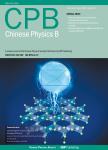Leakage current reduction by thermal oxidation in Ni/Au Schottky contacts on lattice-matched In_(0.18)Al_(0.82)N/GaN heterostructures
Leakage current reduction by thermal oxidation in Ni/Au Schottky contacts on lattice-matched In_(0.18)Al_(0.82)N/GaN heterostructures作者机构:State Key Laboratory of Artificial Microstructure and Mesoscopic Physics School of Physics Peking University Institute of Microelectronics of Chinese Academy of Sciences
出 版 物:《Chinese Physics B》 (中国物理B(英文版))
年 卷 期:2014年第23卷第3期
页 面:493-497页
核心收录:
学科分类:080903[工学-微电子学与固体电子学] 0809[工学-电子科学与技术(可授工学、理学学位)] 08[工学] 080501[工学-材料物理与化学] 0805[工学-材料科学与工程(可授工学、理学学位)] 080502[工学-材料学] 0704[理学-天文学]
基 金:Project supported by the National Natural Science Foundation of China(Grant Nos.60444007 11174008 60325413 and 10774001)
主 题:leakage current thermal oxidation Frenkel-Poole emission
摘 要:By using temperature-dependent current-voltage, variable-frequency capacitance-voltage, and Hall measurements, the effects of the thermal oxidation on the electrical properties of Ni/Au Schottky contacts on lattice-matched Ino.18Alo.82N/GaN heterostructures are investigated. Decrease of the reverse leakage current down to six orders of magni- tude is observed after the thermal oxidation of the Ino.18Alo.82N/GaN heterostructures at 700 ℃. It is confirmed that the reverse leakage current is dominated by the Frenkel-Poole emission, and the main origin of the leakage current is the emis- sion of electrons from a trap state near the metal/semiconductor interface into a continuum of electronic states associated with the conductive dislocations in the InxAll-xN barrier. It is believed that the thermal oxidation results in the formation of a thin oxide layer on the InxAll-xN surface, which increases the electron emission barrier height.



